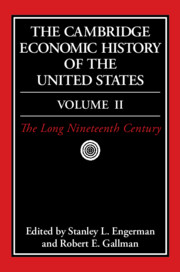Book contents
- Frontmatter
- 1 Economic Growth and Structural Change in the Long Nineteenth Century
- 2 The Economy of Canada in the Nineteenth Century
- 3 Inequality in the Nineteenth Century
- 4 The Population of the United States, 1790–1920
- 5 The Labor Force in the Nineteenth Century
- 6 The Farm, The Farmer, and The Market
- 7 Northern Agriculture and the Westward Movement
- 8 Slavery and its Consequences for the South in the Nineteenth Century
- 9 Technology and Industrialization, 1790–1914
- 10 Entrepreneurship, Business Organization, and Economic Concentration
- 11 Business Law and American Economic History
- 12 Experimental Federalism: the Economics of American Government, 1789–1914
- 13 Internal Transportation in the Nineteenth and Early Twentieth Centuries
- 14 Banking and Finance, 1789–1914
- 15 U.S. Foreign Trade and the Balance of Payments, 1800–1913
- 16 International Capital Movements, Domestic Capital Markets, and American Economic Growth, 1820–1914
- 17 The Social Implications of U.S. Economic Development
- Bibliographic Essays
- Index
2 - The Economy of Canada in the Nineteenth Century
Published online by Cambridge University Press: 28 March 2008
- Frontmatter
- 1 Economic Growth and Structural Change in the Long Nineteenth Century
- 2 The Economy of Canada in the Nineteenth Century
- 3 Inequality in the Nineteenth Century
- 4 The Population of the United States, 1790–1920
- 5 The Labor Force in the Nineteenth Century
- 6 The Farm, The Farmer, and The Market
- 7 Northern Agriculture and the Westward Movement
- 8 Slavery and its Consequences for the South in the Nineteenth Century
- 9 Technology and Industrialization, 1790–1914
- 10 Entrepreneurship, Business Organization, and Economic Concentration
- 11 Business Law and American Economic History
- 12 Experimental Federalism: the Economics of American Government, 1789–1914
- 13 Internal Transportation in the Nineteenth and Early Twentieth Centuries
- 14 Banking and Finance, 1789–1914
- 15 U.S. Foreign Trade and the Balance of Payments, 1800–1913
- 16 International Capital Movements, Domestic Capital Markets, and American Economic Growth, 1820–1914
- 17 The Social Implications of U.S. Economic Development
- Bibliographic Essays
- Index
Summary
FOUNDATIONS OF THE NINETEENTH-CENTURY CANADIAN ECONOMY
For the economy of Canada it can be said that the nineteenth century came to an end in the mid-1890s. There is wide agreement among observers that a fundamental break occurred at about that time and that in the years thereafter Canadian economic development, industrialization, population growth, and territorial expansion quickened markedly. This has led economic historians to put a special emphasis on the particularly rapid economic expansion that occurred in the years after about 1896. That emphasis has been deceptive and has generated a perception that little of consequence was happening before 1896. W. W. Rostow was only reflecting a reasonable reading of what had been written about Canadian economic history when he declared the “take-off” in Canada to have occurred in the years between 1896 and 1913. That was undoubtedly a period of rapid growth and great transformation in the Canadian economy and is best considered as part of the twentieth-century experience. The break is usually thought to have occurred in the mid-1890s, but the most indicative data concerning the end of this period are drawn from the 1891 decennial census. By the time of the next census in 1901, major changes had begun to occur. It fits the available evidence best, then, to think of an early 1890s end to the nineteenth century.
- Type
- Chapter
- Information
- The Cambridge Economic History of the United States , pp. 57 - 108Publisher: Cambridge University PressPrint publication year: 2000



